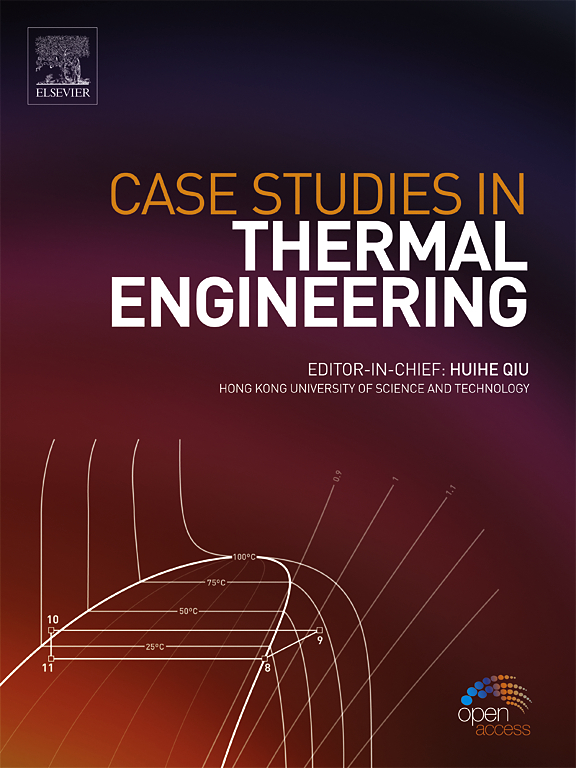燃煤电厂灵活改造用熔盐蒸汽发电系统的动态模拟与控制策略开发
IF 6.4
2区 工程技术
Q1 THERMODYNAMICS
引用次数: 0
摘要
燃煤发电厂(CFPP)与熔盐热能储存系统的结合是提高其灵活性和调峰能力的一种潜在方法。蒸汽发生系统(SGS)是利用熔盐热量将给水转化为热蒸汽的合适选择。本文介绍了与 CFPP 相结合的 SGS 的原理图。建立并验证了基于块参数法的 SGS 动态模型,以研究其动态响应特性。对包括给水入口参数、熔盐入口参数和中压蒸汽阀在内的五个不同干扰实验进行了分析。得到了熔盐和蒸汽的动态响应曲线。此外,还比较了额定工况下三种不同负载变化率(3 %、6 %、10 % Pe/min)的 SGS 负载调整过程,并分析了其对 SGS 的影响。SGS 厚壁元件的温度变化率在 2 °C/min 以内,符合安全运行标准。基于上述结果,针对 SGS 安全运行提出并演示了鲁棒性极佳的三要素控制策略。结果表明,采用三要素控制策略后,SGS 负荷调节过程的响应时间和水位波动都得到了显著改善。当 SGS 负载降低 10% 的热负荷,负荷变化率为 10% Pe/min 时,水位可在 200 秒内稳定下来,波动很小。这些结果可为结合熔盐储热系统的 CFPP 的设计和控制策略的制定提供有益的参考。本文章由计算机程序翻译,如有差异,请以英文原文为准。
Dynamic simulation and control strategy development of molten salt steam generation system for coal-fired power plant flexible retrofit
The coal-fired power plant (CFPP) coupled with the molten salt thermal energy storage system is a potential way to improve its flexibility and peak-shaving ability. The steam generation system (SGS) is a suitable choice to convert the feed water into hot steam by using the heat from the molten salt. In this paper, the schematic of an SGS coupled with the CFPP is presented. A dynamic model of the SGS basing lump parameter method is established and validated to investigate its dynamic response characteristics. Five different disturbance experiments including feed water inlet parameters, molten salt inlet parameters and medium pressure steam valve, are conducted and analyzed. The dynamic response curves of molten salt and steam are obtained. Moreover, the load adjustment process of SGS with three different load changing rates (3 %, 6 %, 10 % Pe/min) under the rated conditions is compared and its influence on the SGS is analyzed. The temperature changing rates in the thick-wall components of SGS are within 2 °C/min which meets the safe operating standard. Based on the above results, the three elements control strategy with excellent robustness for the SGS safety operation is proposed and demonstrated. The results show that the response time for the SGS load regulation process and the water level fluctuation have been significantly improved as the three elements control strategy is imposed. The water level can be stabilized in 200 s with tiny fluctuation when the SGS loads down 10 % thermal load with 10 % Pe/min load changing rate. These results could provide useful references for the design and control strategy making of the CFPP coupled with the molten salt thermal energy storage system.
求助全文
通过发布文献求助,成功后即可免费获取论文全文。
去求助
来源期刊

Case Studies in Thermal Engineering
Chemical Engineering-Fluid Flow and Transfer Processes
CiteScore
8.60
自引率
11.80%
发文量
812
审稿时长
76 days
期刊介绍:
Case Studies in Thermal Engineering provides a forum for the rapid publication of short, structured Case Studies in Thermal Engineering and related Short Communications. It provides an essential compendium of case studies for researchers and practitioners in the field of thermal engineering and others who are interested in aspects of thermal engineering cases that could affect other engineering processes. The journal not only publishes new and novel case studies, but also provides a forum for the publication of high quality descriptions of classic thermal engineering problems. The scope of the journal includes case studies of thermal engineering problems in components, devices and systems using existing experimental and numerical techniques in the areas of mechanical, aerospace, chemical, medical, thermal management for electronics, heat exchangers, regeneration, solar thermal energy, thermal storage, building energy conservation, and power generation. Case studies of thermal problems in other areas will also be considered.
 求助内容:
求助内容: 应助结果提醒方式:
应助结果提醒方式:


